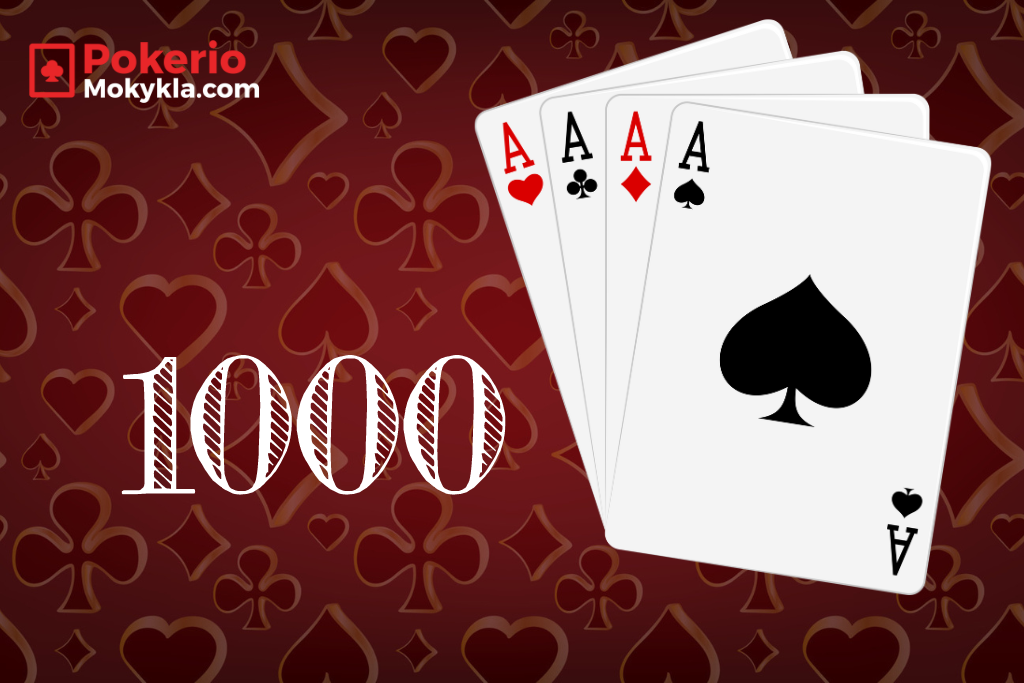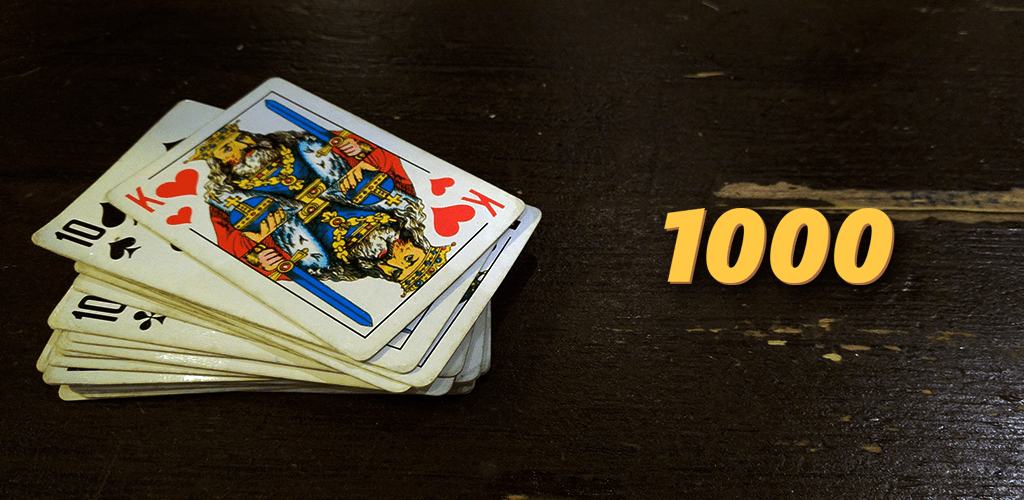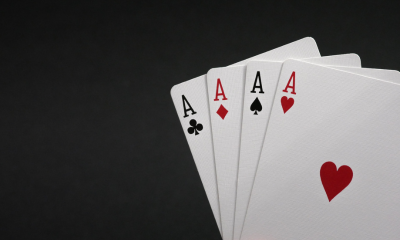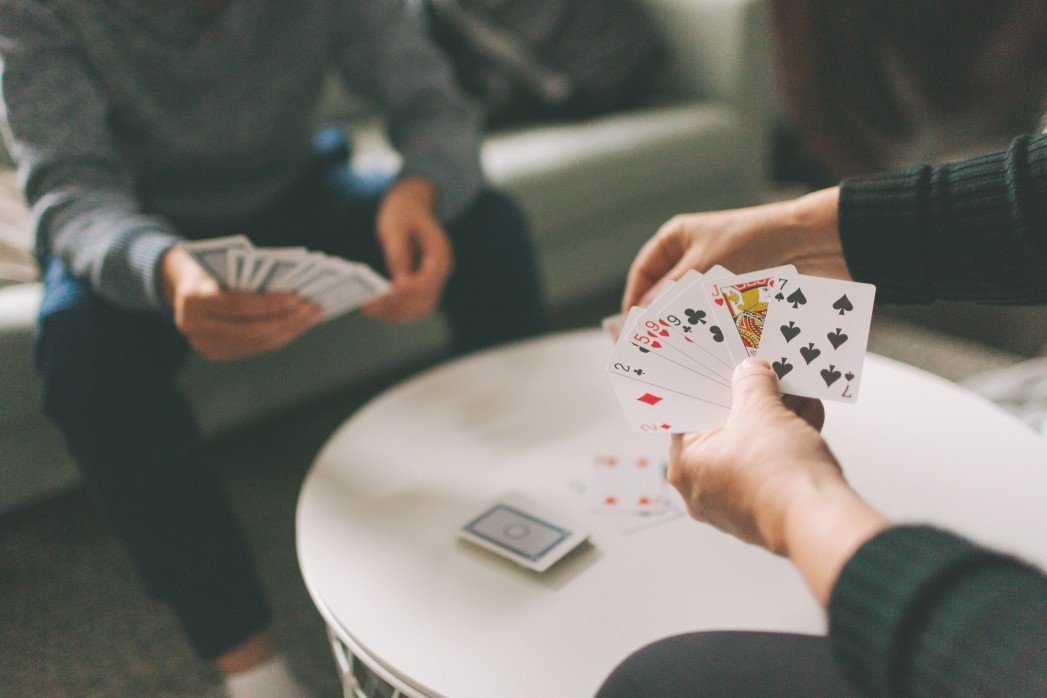
Rules of the game Thousand
How many players play?
The card game Thousand is played by 2, 3, or 4 players.
Materials needed for the game
The card game Thousand is played with a traditional deck of cards, usually with 24 cards. The card rank order is as follows: ace (11 points), ten (10 points), king (4 points), queen (3 points), jack (2 points), nine (0 points). In total, the deck has 120 points (4×11 + 4×10 + 4×4 + 4×3 + 4×2).
Who deals the cards first is usually decided by drawing lots. Later, for the next game, the cards are dealt clockwise – the player sitting to the left becomes the dealer.
Objective of the card game Thousand
To be the first to collect the most points – 1000 points.
Best casinos for games:
Card game Thousand. How to play?
When 4 players play
The dealer thoroughly shuffles the cards and first gives them to the player sitting on the right to cut. Then the cards are dealt to all players (except the dealer) – first 3 cards each, and 3 face-down cards are placed on the table (these are called the Purchase in the game).
Later, 4 more cards are dealt to the players, so each player gets 7 cards in total.
If any player gets 4 nines, they reveal them on the table, and the dealer must collect all the players' cards, shuffle the deck, give it to the player on the right to cut, and deal the cards again in the same manner.
If a player gets 3 nines, they can organize a card lottery. The player places all 3 revealed nines on the table, and the other 2 remaining players place 1 face-down card each – either red or black. The lottery organizer chooses one of their nines, and the first point calculation begins:
If neither player guesses the color of the card chosen by the lottery organizer, the organizer gets the first 100 points.
If one player guesses the color and the other does not, the one who guessed correctly gets 100 points.
If both players guess the color, they each get 50 points.
Each game has “Betting” and “Playing” stages.

Betting stage
After dealing the cards and/or organizing the lottery, the game begins. The player sitting to the left of the dealer is the first to announce their bet, which is usually 100 points, so the player must loudly shout “Hundred!”.
Then the remaining players, in turn, must increase the bet, adding 10 points each time, e.g., 110 or 120.
The bet is increased, and players compete until 2 players in a row say they pass and shout “Pass!”. Moreover, once a player passes, they do not participate in the further rounds of this game. Then the dealer reveals all 3 cards placed on the table at the beginning of the game and gives them to the winner.
In the betting stage, the number of points the player aims to collect by the end of the game is determined. It is worth remembering that the maximum number of points that can be collected is 120, so it might seem that the bet can only go up to 120. However, the game Thousand has special “tips” that make playing much more interesting.
It is important to have not only the highest value cards (ace and ten) but also card “pairs” – a king and queen of the same suit.
Each pair of cards of the same suit also has different point values:
Spades king and queen – 40 points
Clubs king and queen – 60 points
Diamonds king and queen – 80 points
Hearts king and queen – 100 points
It is important to note that you can also change your bet if you get a pair of the same color – black or red – with those 3 cards, as mentioned, they increase the value of the purchase.
In this case, you can increase your bet to more than 120 points, for example, if you have a spades king and queen, your bet can be up to 160 points, if you have a hearts king and queen – 220 points.
Another important point
Having a pair only allows you to add an additional point sum because when the “Playing” stage begins, you might not actually score any points. If a player sees that they will not collect the required number of points to win the game, they can refuse to play once during the entire game.
Then both of their opponents are awarded 60 points each. Why increase the bet? The answer is simple – this way, you get closer to winning.
After the betting stage, the player who announced the highest number of points they plan to collect has the right to take the 3 face-down cards on the table.
At that moment, the player has 10 cards in their hand but must distribute 1 card to each of their opponents.
Interestingly, the player does not have to give away the 3 cards from the table – they can freely choose to give away cards they already had.
The game Thousand then continues with 8 cards for each player. There are also slightly different variations of the game – the winner of the purchase may not distribute the cards but keep them, placing 3 unnecessary face-down cards on the table and later placing the taken tricks on them.
In this case, players continue “Thousand” with 7 cards.
The purchase can also be won in a special way, which would bring you even more points. A risk-loving player can compete and place bets without even looking at their cards. This betting stage can be called “blind” or “dark”.
If other game opponents state a number of points that the latter no longer wants to exceed, then he can look at his cards and then has 2 options – to play and compete further in the usual way or to pass.
By purchasing in this way:
Both winning and losing are valued double;
If you refuse to play (pass), opponents receive 120 points each;
The dealer looks at the purchase cards without showing them to others and gives them face down to the buyer.
Moreover, the card dealer essentially does not participate in the game, he “sits” and earns the number of points of the purchase cards for the deal.
Game Stage
After the betting stage, the game with tricks begins. The first card is played by the player who wins the purchase. Each player's cards are played one by one in a clockwise direction.
The player who starts a new round of tricks essentially determines the main suit and rank of the cards for the opponents.
Also, when playing with cards of the same suit, you must play a higher card than your opponent's if you want to win the trick. If it happens that you no longer have cards of that suit – you can play a card of the opposite suit (also of any value).
It is important to think logically – if you do not have a card of the same suit or a trump, which is determined by playing pairs (the played queen determines the trump of that trick) or your opponents do not have them either, it is always best to discard nines, which are essentially worthless cards.

A simple example:
Player A: king, jack, nine (hearts)
Player B: queen and ten (hearts)
Player C: ace (hearts)
Player A starts the move and plays the king of hearts (4 points).
Player B in this case must play a higher value card of the same suit – the ten (10 points). Logically, the player should not play the queen, as it is of lower value (3 points) than the king, unless player A had played the jack (2 points) or the nine (0 points).
Player C in this case has the highest value card – the ace (11 points). He plays it on the table, wins the trick, and starts a new round.
Another important moment in the game is that you can score points by having the mentioned pairs of king and queen.
Moreover, the action with pairs (tricking with the queen in hand also having the king) is important when you want to maintain a certain suit and rank for further play, for example, you play the queen and the next card will be black clubs – in this way you determine the trump of the trick.
The next move must be made with the king of clubs and other club trumps.
Some possible trick outcomes with a trump:
Opponents also play the king of clubs and the ace of clubs, but you do not win the trick. It is won by the player who played the ace, as it is the highest trump card.
If the players had played the king of hearts and the ace of hearts, you would still win the trick, even though you have a lower value card – the queen, but at the same time the most powerful at the current moment – the trump.
Another interesting game when playing with pairs is that the final suit and rank of the cards – the trump – is determined by the one who last played a card on the table.
For example, you have a pair of hearts, your opponent – a pair of diamonds. Your opponent first plays the queen of diamonds, thus determining the trump of the game, but you play the queen of hearts and immediately change the trump to your advantage! That's why this game is so dynamic and interesting.
When all moves and tricks are made (a total of 7 or 8), it's time to count the points! If you are the leading player and want to become the winner, you must confirm that you have collected the initially bet number of points, e.g., 160 points, also having a pair of clubs increases the chances of winning and collecting 103 points in tricks. If you collected such numbers – congratulations, you won this round!
Determining the Winner and Counting Points
As mentioned, the leading player must confirm that they have collected the initially bet number of points. If they do not collect – the number of points collected in this round must be subtracted from the total sum of points collected from previous games.
Other players count their points and if the sum ends in digits 0-5, the final sum is rounded down, if 6-9 the sum is rounded up.
For example, if you collected 53 points, it is rounded to 50, and if you collected 56 points, the sum is rounded to 60 points.
So, the game is won by the one who first collects 1000 points.
Special Rules for the Card Game Thousand
If you want the game to become even more dynamic, more complex and more fun to think about, you can use these tricks in the game:
“Leftover 100”
This situation occurs in the betting phase. One of the rules is that the player to the left of the dealer must start the bet by saying “One hundred!”. Sometimes it happens that both of the following players pass and must play with the bet amount, even if they do not want to.
In this case, it is usually agreed that the player takes the 3 cards initially placed on the table and does not show them to the opponents and uses them for their needs.
“Bomb”
This situation also happens when placing bets. The winner of the bets takes the 3 cards placed on the table, looks at them, and might say something to express their dissatisfaction, for example: “Oops! I was expecting completely different cards.”
If you see that you won't collect the required number of points-eyes you initially stated (and it's likely you'll lose the game), you can throw a real “bomb,” which means the round doesn't proceed, and your opponents immediately get an additional 60 eyes each (a total of 120 eyes divided by 2) added to their total points.
Instead of subtracting the collected points from your total points, you draw a big dot – a “bomb” – on the points calculation table. It has been agreed that each player can use such “bombs” 3 times in each game.
Of course, you can't abuse this trick! Although it will help you avoid losing immediately, it won't save you from failure if you don't think logically and strategically.
“800 and Stuck”
By choosing this trick, players who collect 800 or more points cannot use other tricks in the game, except when the player wins the betting game and takes 3 cards from the table.
If the latter loses the game and their total points decrease, they can use all the tricks again – both the “Bomb,” the “Leftover 100,” and the remaining ones. This trick allows you to “stay” in the game a bit longer.
“17 or Less? No, Thank You!”
After dealing the cards and it turns out that the total of 7 cards is 17 eyes or less, you have the right to show your cards to your opponents and ask for the cards to be dealt again.
The same situation happens when you get 4 nines. You must perform this action before the bets – if you're late, unfortunately, the train doesn't wait for the sleepers.
If this happens even 2 times in a row, the card dealer immediately loses 100 of their points and passes the dealing to the player sitting on the left.
Card Game Thousand for Two
“Thousand” can also be played by two, just with fewer cards. Usually, each player gets 6 cards, and the rest are set aside. Every other game is started by a different player. The first player to start the game by agreement must collect 100 or 120 points.
If they don't collect the required number of points, they get a minus (just like when playing with four and the points are subtracted after winning the 3-card purchase).
In the next game, the other player must collect a certain number of eyes. Also, if such rules are not satisfactory, you can play without point subtraction, as the game can take a very long time.

After a cut, players take one card each from the deck and continue collecting cards until the deck is empty and the cards are played.
Another variant of the game for two is possible. Both players share 8 cards each and make 2 card banks of 4 cards each.
Again, bets are placed, and the winner takes one of the banks and gives 2 unnecessary cards to the opponent. The other bank remains untouched until the end of the game.





